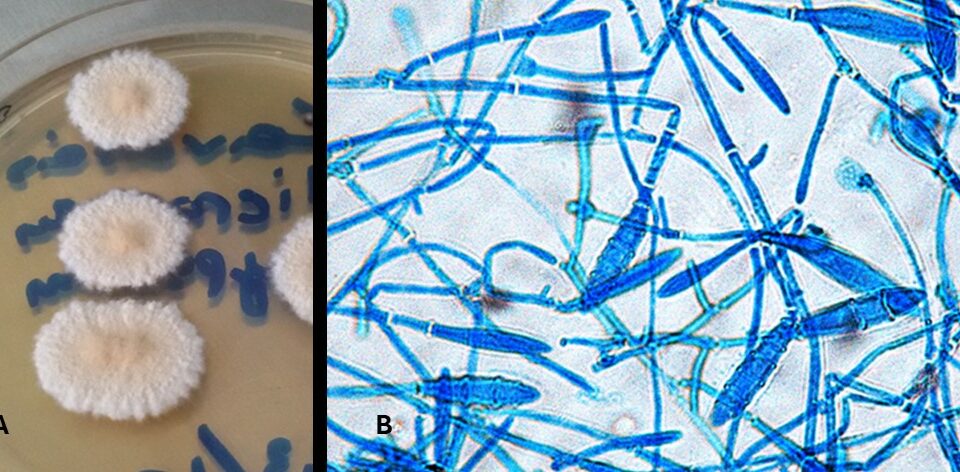
22nd Congress of the International Society for Human and Animal Mycology (ISHAM), 20-24 May 2025
November 1, 2024
11th Trends in Medical Mycology, (20-23 October 2023, Athens, Greece)
November 29, 2024
(Photo: M. Drogari-Apiranthitou, Infectious Diseases Research Laboratory/4th Department of Internal Medicine, National and Kapodistrian University of Athens)
Fusarium spp. - Fusarium keratitis
Fusarium species are the most frequent causative agents of keratitis worldwide (Szaliński et al., 2021). They are widespread in soil, subsoil, and plants, and have also been detected in the air and marine aquatic environment (Sáenz et al., 2020).
Fusarium spp. keratitis is considered an emergency health issue. Without proper treatment the infection progresses inexorably to corneal perforation, endophthalmitis and eventually loss of the eye. It is estimated that 42%-52.5% of all cases of fungal keratitis are caused by species in the genus of Fusarium, with most cases recorded in tropical countries. These cases predominantly affect young men, particularly farmers, and are often associated with post-traumatic events (Hoffman et al., 2021b, Manikandan et al., 2019). In temperate climate countries, cases of Fusarium keratitis more often involve women and are associated with the use of contact lenses.
In Greece, Fusarium spp. were the most frequent causative agents (61.8%) isolated from filamentous fungal keratitis cases. F. solani was mainly associated with injury, while F. verticillioides and F. proliferatum with the use of soft contact lenses (Mbakosi et al., 2022).
[Case editor: M. Drogari-Apiranthitou, Research Laboratory of Infectious Diseases, 4th Dept of Internal Medicine, National and Kapodistrian University of Athens] (from the PhD thesis of Dr A. Mbakosi, MD Microbiologist, National and Kapodistrian University of Athens, 2023)]
References
Hoffman, J. J., Burton, M. J., & Leck, A. (2021b). Mycotic Keratitis-A Global Threat from the Filamentous Fungi. Journal of Fungi (Basel, Switzerland), 7(4). https://doi.org/10.3390/JOF7040273.
Manikandan, P., et al. (2019). Fungal Keratitis: Epidemiology, Rapid Detection, and Antifungal Susceptibilities of Fusarium and Aspergillus Isolates from Corneal Scrapings. BioMed Research International, 2019. https://doi.org/10.1155/2019/6395840.
Mpakosi A, et al. (2022). Filamentous Fungal Keratitis in Greece: A 16-Year Nationwide Multicenter Survey. Mycopathologia, 187(5-6):439-453. https://doi.org/10.1007/s11046-022-00666-1.
Sáenz, V., Alvarez-Moreno, C., Pape, P. Le, Restrepo, S., Guarro, J., & Ramírez, A. M. C. (2020). A One Health Perspective to Recognize Fusarium as Important in Clinical Practice. Journal of Fungi (Basel, Switzerland), 6(4), 1–13. https://doi.org/10.3390/JOF6040235.
Szaliński, M., et al. (2021). Fusarium Keratitis-Review of Current Treatment Possibilities. Journal of Clinical Medicine, 10(23). https://doi.org/10.3390/JCM10235468.



